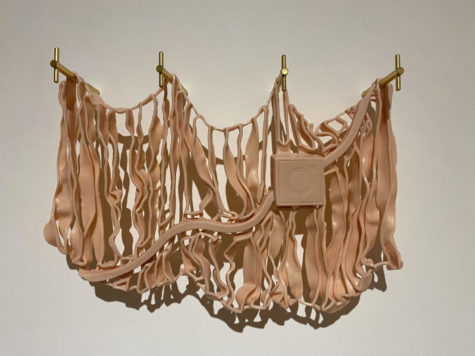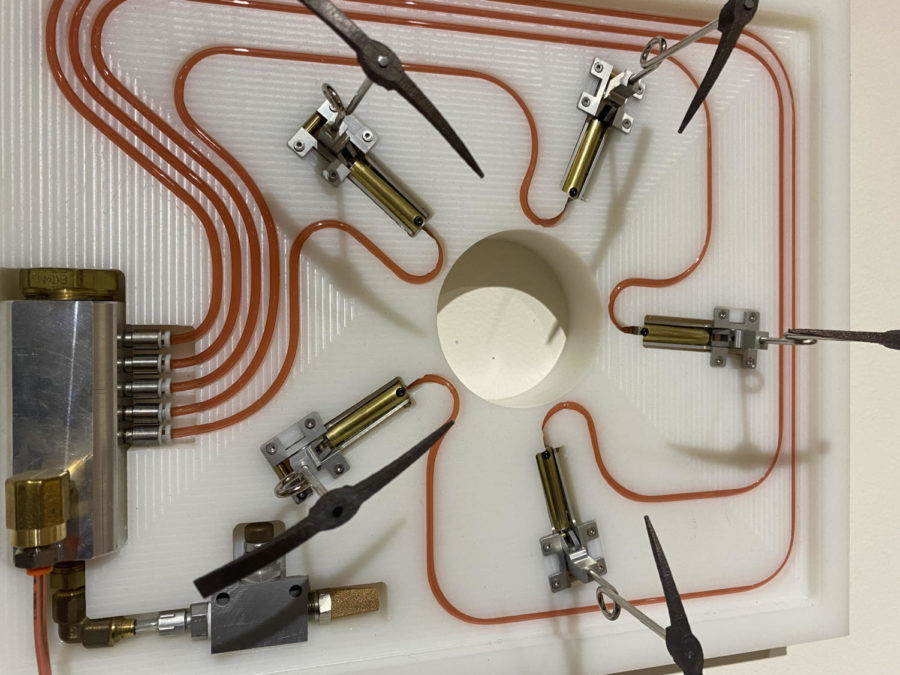Sam Blanchard’s “Futile State” explores the connection between humans and technology
The contemporary art exhibit features machines that visitors can interact with
“Another Exercise in Futility” (2016) invites visitors to interact with Blanchard’s work.
February 8, 2023
Artist and Virginia Tech visual arts professor Sam Blanchard gave a lecture on Jan. 24 about his works installed in the latest exhibit of Washington and Lee’s Staniar Gallery.
His exhibit, titled “Futile State,” which opened on Jan. 9, includes a variety of machines, video projections and environments that visitors are encouraged to physically interact with.
Originally trained as a sculpture artist, Blanchard has been experimenting and working with technology since he was a boy playing with his father’s tools in their garage.
“I’m not an engineer by any means,” Blanchard said. “I’m an artist, so I really try to build my creations on simple principles—a switch, a motor, a circuit.”
But with two fine arts degrees under his belt and two decades of successful technology-based exhibitions both in the United States and abroad, Blanchard feels comfortable describing himself as not just a professional artist, but a technologist, mechanic and performer as well.
His work, he says, is designed to serve as a metaphor for the “lived human experience” in the “very digital age of technology” that we live in. Although some of his pieces are meant to be a more personal showcase of his own life, he hopes that viewers of his work will still be able to see themselves in each piece, which is why many of the machines and projections are made to be interactive.
The piece most representative of the “Futile State” exhibit is a 2016 creation called “Another Exercise in Futility” that connects a large compressor to five small 3D-printed bronze pick-axes.
When the button next to the piece is stepped on by a viewer, the compressor turns on, loudly begins building up air pressure and then finally causes the five pick-axes to simultaneously strike the wall before slowly drawing back again.
“I wanted to do a whole little with a whole lot,” Blanchard said. “There’s so much power, so much effort involved with the compressor, but as you can see, the pick-axes are barely even making a dent, barely scratching the paint.”
The point of “Another Exercise in Futility” is a demonstration of the “methodical, steady effort” of modern day machinery and all technology that humans use and take for granted, Blanchard said.
All it takes to start up the exhibit is a gentle step on a button. Although the result is a tiny, barely noticeable dent, the effort from the machine was visibly and audibly present. Blanchard later compared this to a Google search, or a click of the mouse, which takes “practically no effort on a person’s part” and gives an underwhelming result, but requires a lot of behind-the-scenes work from the computer.
Blanchard also explored the changing relationship between people and technology with “A Little Off the Top,” a 2009 piece that features a barber chair atop a tall steel pole with a video of himself silently being given a shave and haircut by a machine projected against the seat.
In the video, Blanchard alternates between looking mildly concerned to outright fearful of the razor-wielding mechanical arm, a choice that he said represented the mistrust that humans still have of machines in certain roles and the continued need for human workers in response to the widespread fear that “one day, machines will replace us all.”

The 2015 “Grill,” a stationary piece, represents Blanchard’s personal experience with masculinity as he balanced fatherhood, his teaching career and his artistic endeavors.
“Grill” is a silicon rubber cast of a Volvo’s radiator grill suspended from the wall by metal valve studs. The Volvo logo, which is an alchemical symbol for iron that has come to depict males, was one that Blanchard saw daily as he would drive his Volvo to work. The silicone is heavy and skinlike, “tired,” yet still flexible, just as Blanchard felt, and yet still rigidly confined by the “masculine” valve studs.
“I really like seeing the duality of materials being juxtaposed,” Blanchard said. “I’m integrating that idea into many of my new pieces.”
One of these new pieces is called “Expectations and Reality,” and features two depictions of Blanchard’s hand. On the left is an imprint made with petroleum jelly encased in a clear piece of plastic, while on the right is a marble handprint inlaid with 24K gold leaf.
“On the left, you have simple materials, cheap materials,” Blanchard said. “The plastic, the VapoRub—we use these all the time, so to me they’re symbols of domesticity and caring. On the right, we have marble and gold, the most bespoke of materials, all strength and luxury.”
Since the piece was produced, Blanchard has still been working to figure out the meaning of it, a process that he says usually takes him “at least a year.”
“Which hand is the expectation and which is the reality?” Blanchard invited the audience to consider. “I don’t know yet, either.”
The Staniar exhibit is Blanchard’s first solo showing since the start of the pandemic. Blanchard has used the time to develop the direction in which he wants his art to go, a journey that includes the open-endedness of “expectation and reality.”
“Futile State” will be open to visitors until Feb. 8. The exhibit includes flashing lights that may trigger photosensitive guests.













